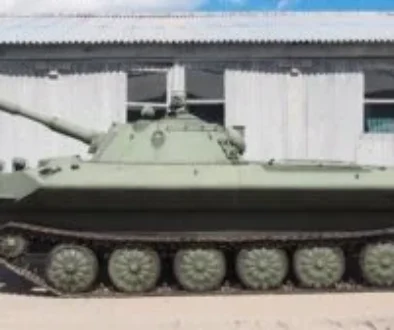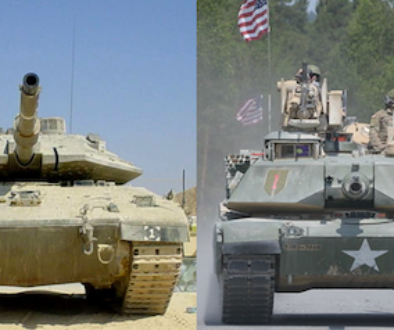GUIDED MISSILES . . .
Intelligence Bulletin – April, 1946!
Last month, the “Intelligence Bulletin” discussed certain overall aspects of atomic warfare. This month it features guided missiles. To the soldier, the field of guided missiles should be of even greater interest than that of atomic fission, for while atomic fission may not be used in warfare, there is every indication that guided missiles will play a great role in any future conflict. Whether guided missiles have atomic warheads, or whether they are atomic or otherwise powered, their possibilities appear to be almost incalculable.
Present possibilities indicate that they might greatly affect conventional air forces and navies, and vastly alter the complexion and composi(ion of ground forces. In any event, they represent another and marvelous means of warfare-a means which will further complicate the sweepingly broad and decisive technical and tactical relationships that make modern war so difficult an art. Because the guided missile field is naturally full of highly classified developments, and because the Germans were first in their visionary promotion of guided missiles projects, the guided missiles field is expounded by a story of the high points of German guided missiles development .
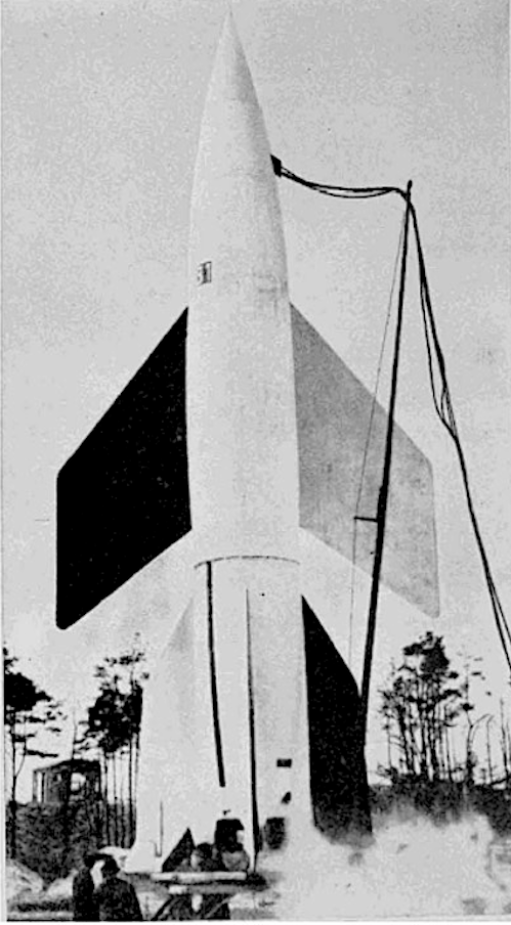
Above:
This is the German A-4 rocket, the furthest development in long-range rocket missiles reached by the Nazis before Germany’s collapse. With this winged version of the familiar V -2, the Nazis planned to bomb every major port in Great Britain. Fortunately, the missile never had time to get beyond the test stage. As pictured here, it is being serviced for a test launching at a German rocket development center.
Late in the war with Germany, newspapers in the United States reported that Germany might launch a rocket attack on New York. This story was discounted by many as alarmist and fantastic. But there is evidence that the Germans had considered just such an attack. For some time prior to the end of the war, the Wehrmacht actually had on the drawing boards a weapon which, fired from German-hdd soil, could reach across the Atlantic. It is a shock to realize that this weapon was originally scheduled for operational use as early as February 1946.
That such a weapon was actually under development in the German Heereswaffenamt as a safe and sane project illustrates perhaps better than anything else the importance and potentialities of a coming new class of weapon-the guided missile, as the giant German rocket should be technically termed.
Secondly, the term “guided” means that the missile is equipped with some kind of controlling or guiding agent. This agent may be carried within the missile homing devices activated by the target itself, automatic pilots set prior to launching, or a human pilot-as in the Jap Baka bomb, or they may be external, exerting control by wire from a parent plane or by a radar-radio system.
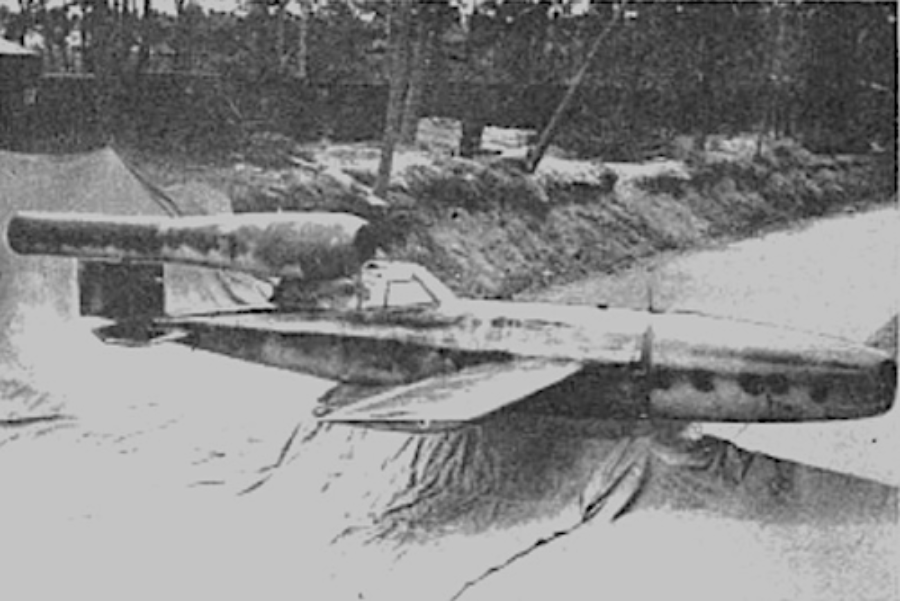
Above:
The Germans, like the japanese, tried to introduce a human guiding mechanism for one version of their V-1. Like the Jap “Baka,” this was intended for use as an anti-invasion fleet weapon. Unlike the “Baka,” it was never used.
Lack of friction means the attainment of greater speeds and greater ranges for guided missiles. Greater speeds also mean that the effectiveness of countermeasures is reduced in proportion to the speed increase. Therefore, it has been the above-surface guided missiles which have given recent promise of effecting great changes in modern warfare. So far, the most favored propulsion methods for above-surface guided missiles tend to be those first exploited by Germany.
One type is that used in the famous V-1: jet propulsion. In this type, oxygen for the combustion process providing the propulsive force is obtained from surrounding air. The second type of propulsion is that of the rocket in which the oxygen is contained within the rocket· fuel. The rocket principle is important to grasp, for many people have not yet caught up with Isaac Newton. They don’t realize that a bazooka or a V-2 rocket gains its thrust, not from pushing against the air, but by being blown forward by the energy of the explosion train ( accelerated combustion) of its own fuel.
The consequences are significant: While a jet-propelled missile must stay within the limits of the atmosphere so that it can draw in oxygen for fuel combustion, the rocket can travel below the surface of the water, in the air, and in space. Right now, the rocket is the only weapon of space warfare that is in sight. Though guided missiles traveling above the earth’s surface all tend to attain extremely high speeds, not all of them necessarily need to be perfectly streamlined. If part or all of the flight path is to be made within the atmosphere, it may be convenient to provide wings. The wings’ purpose may not only be to increase the range by reducing the glide angle, they may actually furnish the lift to support the missile, as in the V-1. Control surfaces may also be provided, varying in size with the amount of control it is desired to exert.
Wings, control surfaces, and other exterior features all hamper a missile’s speed. Winged missiles can nevertheless attain fantastic velocities, so that by and large the science of guided missiles must pass on from the field of aerodynamics into that of ballistics. While plane makers today are talking of attaining the speed of sound (approximately 1,000 feet per second), the “common” or “garden” variety of guided missile may easily be supersonic-may travel at the rate of speed of a rifle bullet or artillery projectile. German guided missiles like the V-2 have hit velocities which were above those of the most powerful German 88-mm AP ammunition.

Above:
The German Army got the idea of using guided missiles back in 1918, when the use of wire-control was conceived as a means of increasing bombing accuracy. This diagram shows a German World War II wire-controlled bomb.
The aircraft represents an extension of the capabilities of the artillery piece in certain respects. especially as regard long-range work. The aircraft actually picks up the projectile (bomb) or even the gun itself and carries it fairly close to the targel.
ln so doing. the aircraft experts control over the projectile (bomb) for a far greater time tl1an would a gun firing a projectile over the trajectory covered by the flight of the plane from base to target. The guided missiles represent the greatest advance. in that control may he exercised from the moment of launching up to the moment of impact. without the need of an aircraft ferry. Like an artillery position, a launching site for such a guided missile can be protected and concealed. and can be made mobile lo assist in securing protection. In contrast, the aircraft of today must not only secure its extensive base, but must expose itself and its crew members to the teeth of enemy defenses, in order to get off a conventional, free-dropping bomb. It also has lo gel itself back to its base. The ground-launched guided missile need have no such shortcomings. Its main defect, compared to the conventional artillery projectile, is the necessity of its carrying along the dead weight of its fuel and “motor” system features which the artillery projectile leaves behind in its gun.
The really big program was initiated by some young civilian technical scholars. Inspired by a futuristic book on rockets by ·a German professor, they banded together and began experiments in 1929. Their high point was the development of a rocket which successfully carried the mail over the Alps into Austria. Lacking funds for proper advanced experimentation, they sold their idea to the German Army, which took up them and their work in 1932. The Army had, meanwhile, been working on rocket fuels since 1930, and hence was in a position to push the project when Hitler’s rise to power brought unlimited funds to German war preparations.
The year 1936 saw the construction of the huge experimental station and laboratory at desolate Peenemünde on the Baltic. Operations of that station in the very first year were reported to have been financed by an appropriation of 300,000,000 gold marks (some $100,000,000). Peenemünde remained the big center for the guided missiles business right up until the end of the war, but Germany was dotted with supersonic wind tunnels, some having wind velocities several times the speed of sound, not to mention research and experimental agencies concerned with the development of theory, technique, and the actual test of models. A large portion of Germany’s scientists were kept busy on guided missile work, and, if anything, the Germans spent too much time assembling basic research – that is, if the German High Command were taking into account the deadlines which Hitler was setting for his aggressions. The result was that although the German outlay brought them the V-2 ( which as a surface-to-surface rocket was the main interest of the German Army), practical difficulties and personality clashes kept even that weapon from extensive operational use until 1944, although it was first used against Leningrad in 1943. That this delay was going to ensue became apparent to the Germans after the war had started. Beginning in June 1942, they therefore rushed to get out a missile which could be produced easily and within a reasonable length of time-and also be effective. The weapon so rushed was the V-1.
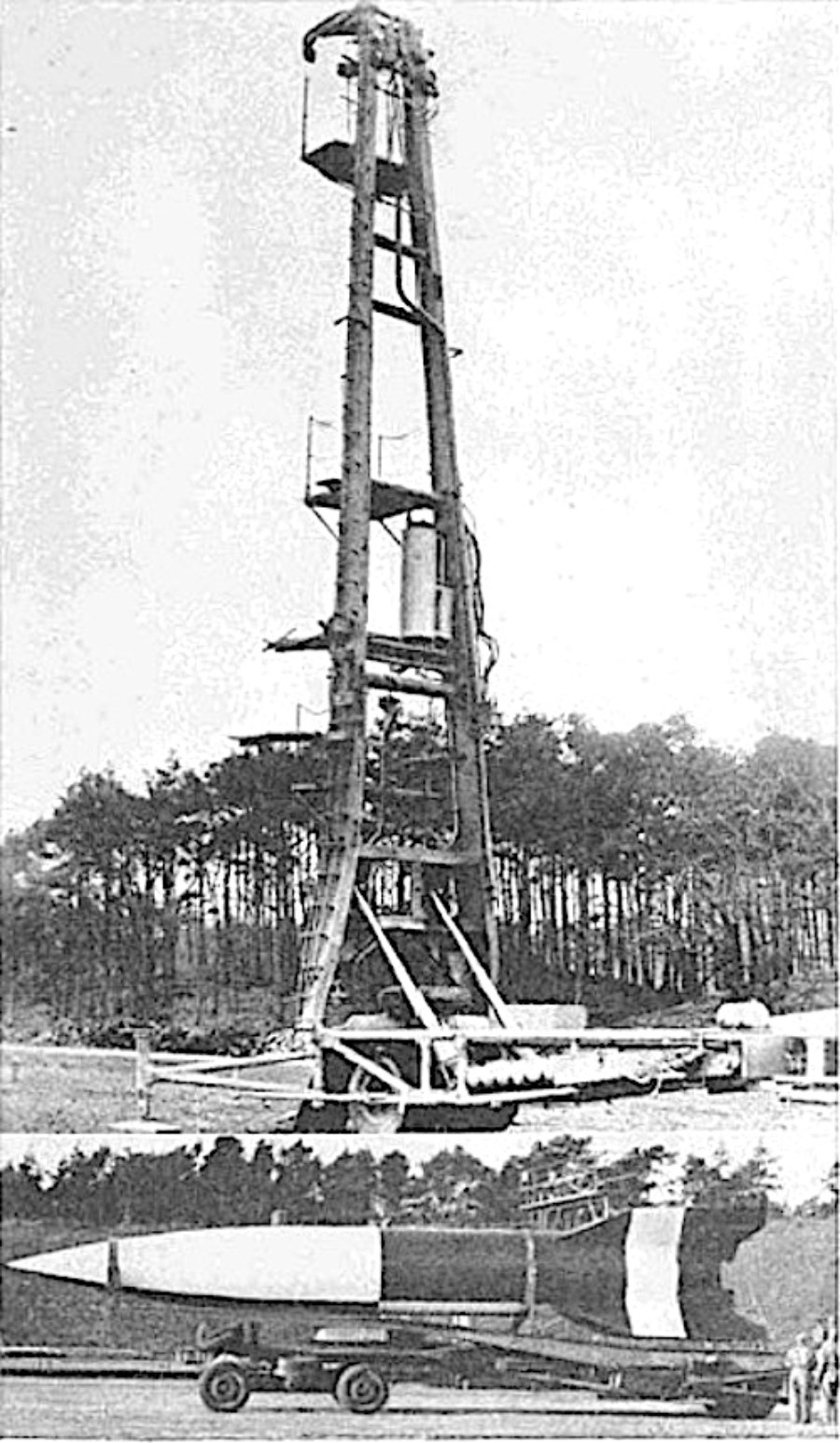

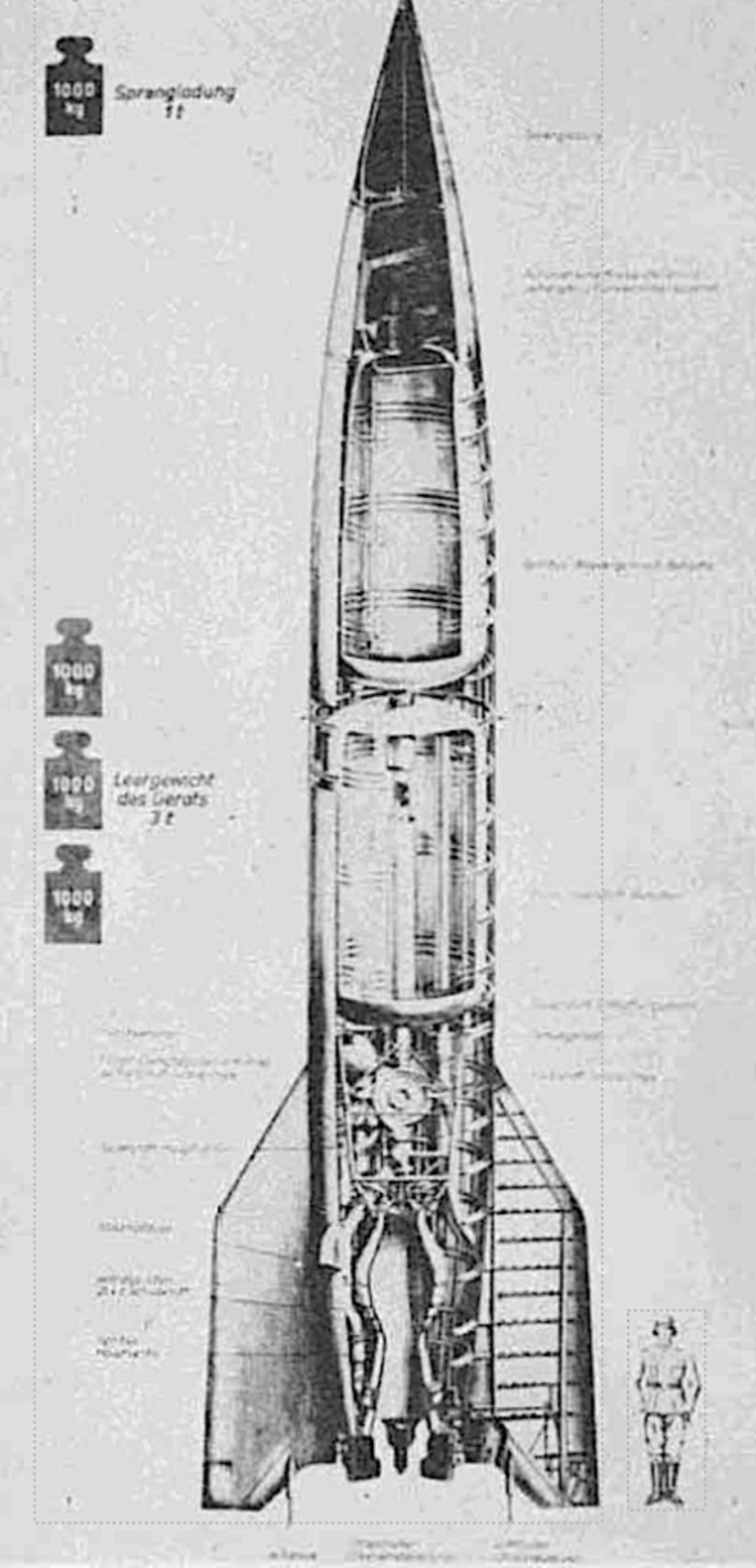
Above:
After carrying the V-2 to its launching site, the trailer shown at the bottom of the picture raised the rocket to vertical for servicing and launching (picture top – Shows raised trailer without rockets.
Above
Once vertical, the V-2 was lowered onto a smaller trailer stand on jacks, then serviced by 30 vehicles, like those above (Middle Picture)
Above:
An official German cross-section of the V2 shows (top to bottom): Warhead with 1 metric ton of explosives (2,205 pounds). Control chamber, alcohol tank, liquid oxygen tank, turbine and combustion chamber. The “leergewicht” is the empty weight of the rocket, given as 3 metric tons
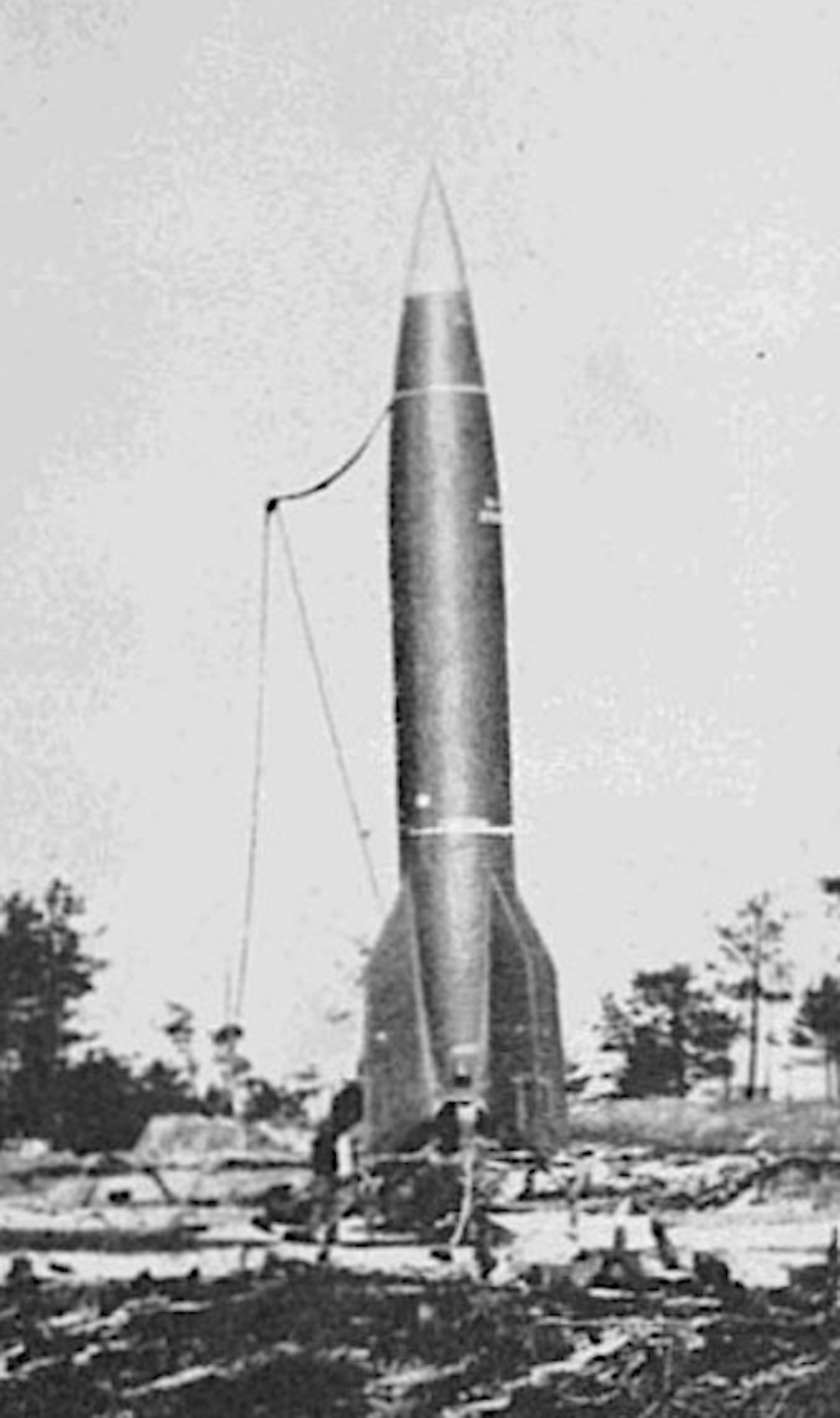
Above:
A significant feature of a V-2 type guided missile is the simplicity of its launching site. In respect to mobility and use of a rapidly prepared and suitably concealed position, these missiles resemble field artillery.
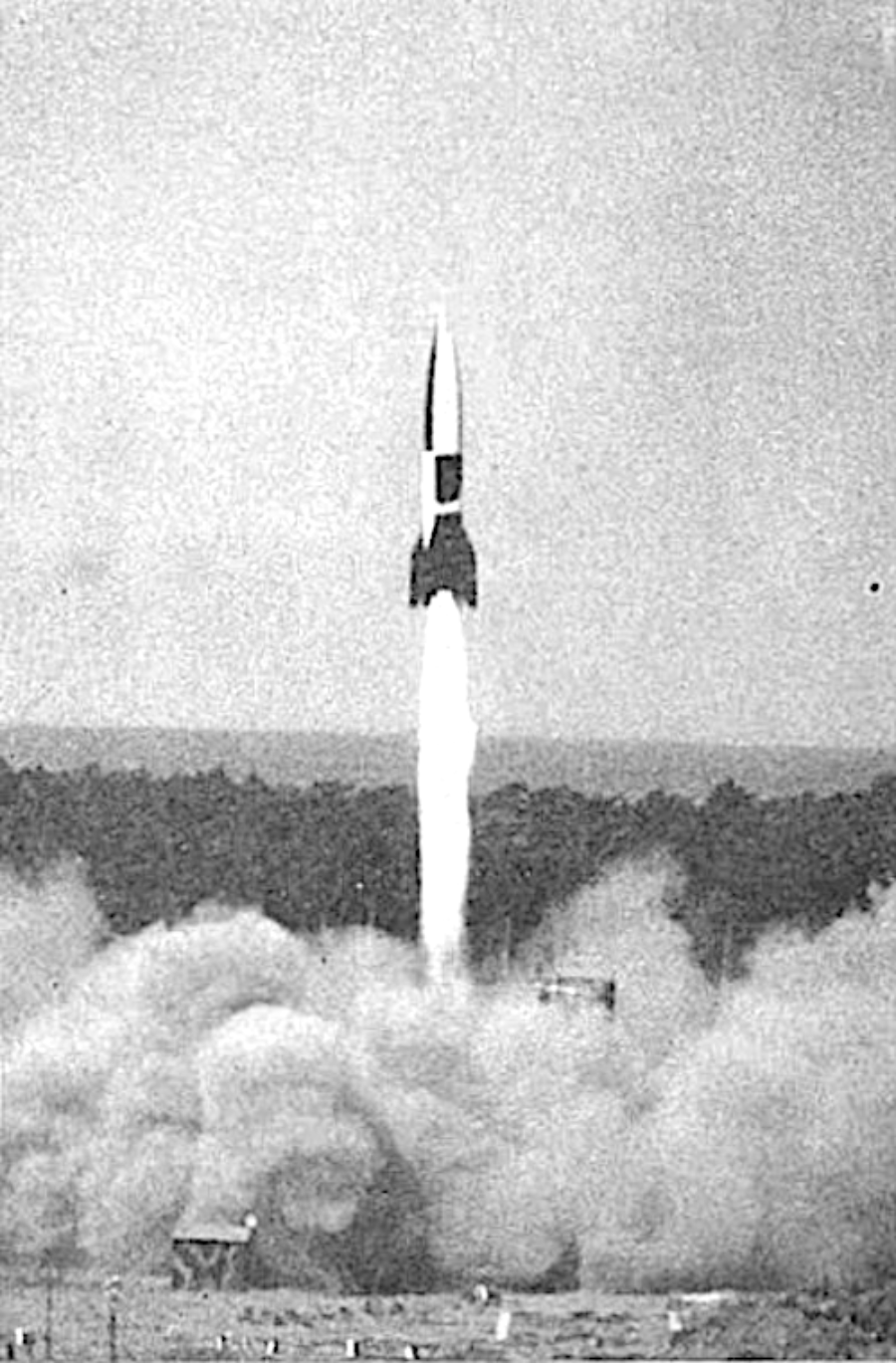
Above:
The V-2 is fired. Its initial rise is majestic and slow but accompanied by considerable blast and dust clouds. This view show a V-2 under test at the German Baltic guided missiles experimental station of Peenemünde.

Above:
While V-2 paths show a wavy vapor trail (top picture), this rocket’s supersonic speed rules out audible warning. Its approach being heard after its explosion. The V-2 thrust into the earth on impact, reducing lateral blast.
It is also fortunate that these researchers did not produce operational airto-ground missiles sooner than 1943. The initial ones that did get into service in the Mediterranean were vicious against shipping; three later-type armor-piercing missiles easily dispatched the new Italian battleship Roma. If they had been ready when Britain’s back was to the wall in 1940-41, the task of the Allies would have been incomparably more difficult. By trying 0-41, the task of the Allies would have been incomparably more difficult. By trying initially for a V-2 long-range rocket, and trying to get it to be extremely accurate, the Germans gave away a great part of their initial advantage in guided missiles development.
German guided missiles may not all have been operational, and those that were may not really have been perfected. But those that did exist still furnish excellent examples of the various types of guided missiles which are capable of being developed.
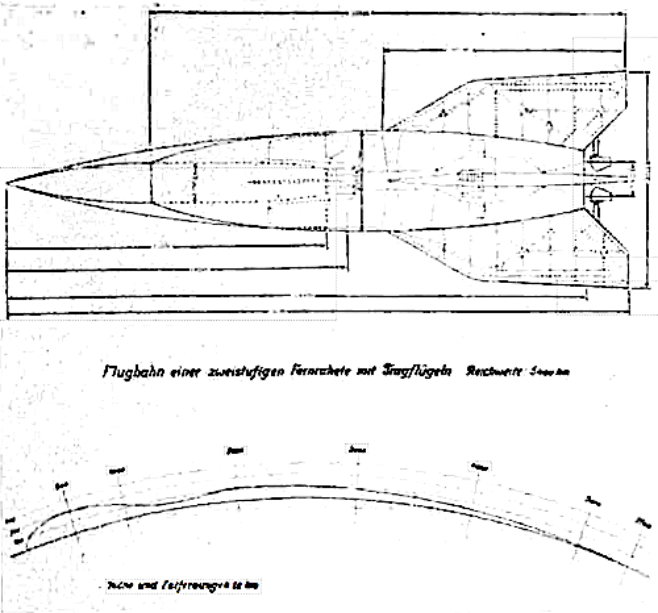
Above -top:
The ultimate of the V-2 type rocket was the A-9/A-10 combination. The former breaking loose from the latter in flight after the A-10 had flown its full course. A project that never reached the test stage, this scheme provided for a range that would have brought the A-9 to America, as the trajectory chart indicates Above
ROCKET PROPULSION
When the A-4 returns to earth; it is dropping at a 45-degree angle. This steep angle, combined with its speed, makes it the more difficult to deal with. However, its re-entry into the layers of heavier air causes great skin friction and consequent heating. These factors caused the Germans considerable trouble, and often resulted in air bursts too high to effect any damage whatsoever. If the danger of breakup or airburst is overcome, a V-2 can hit the earth at an optimum range of about 200 miles from the launching point.
The V-2 represented a terrific effort, production and otherwise, just to deliver a 1-ton warhead. In view of this fact, many have considered that the Germans entertained the idea of using some other explosive than the high explosive actually fitted. While the Nazis would no doubt have jumped at a chance to install a practical atomic warhead, there appears to he no evidence that it was on the books. The Germans’ apparent intent was to compensate for expense of production by providing for a degree of accuracy that proved to he unattainable.
The important thing to remember about the A-4 is that the Germans did not consider it a perfected weapon. Nevertheless, this 200-mile missile was in mass production at the end of the war. The German Army had regular units to man A-4 emplacements, with intricately worked-out special equipment, and with a complete SOP. Buck Rogers as it may appear as a weapon, the Germans had it down to the point where it was fired strictly by the numbers.
THE V-1:
JET PROPULSION
The first of the long-range guided missiles -to make its appearance was the V-1, which the Germans termed the FEG-76. First tested in December 1942, it was not used operationally until June 1944. It would have appeared considerably sooner, had not the entire Peenemünde establishment come in for considerable Allied air attention. Thanks to severe RAF attacks in 1943, the whole German guided missiles program was set back some 6 months, and that included the V-1. The FEG-76, better known as the V-1 (Retribution weapon 1), is a jetpropelled guided missile of the internally controlled type. That is, its guiding mechanism is preset before launching. No further control is exercised by radio, wire, or homing device. An automatic pilot is used to control direction and altitude, while an air-log in the nose registers the distance the missile travels.
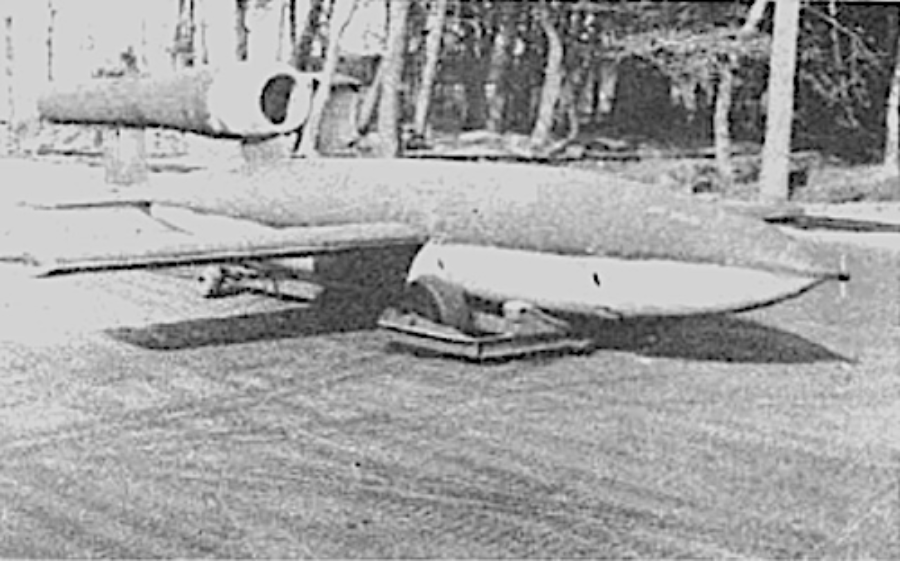
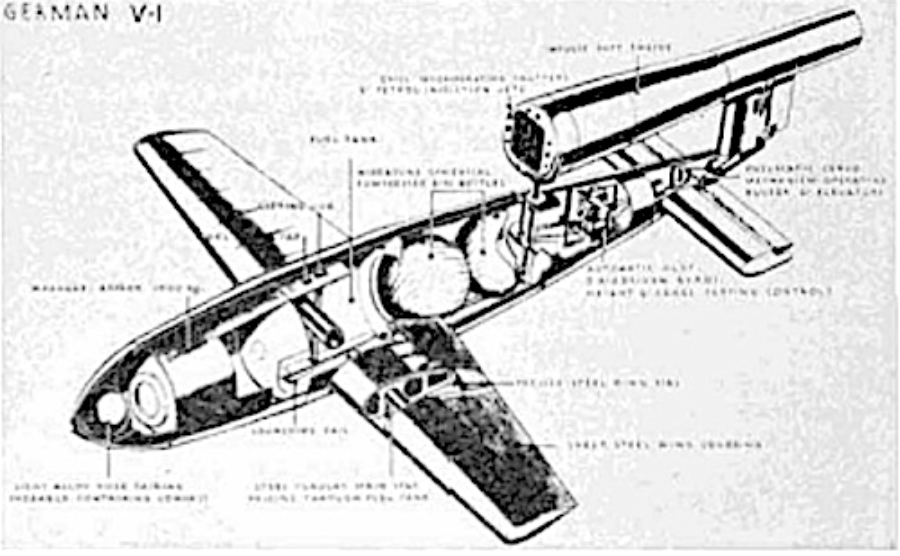
The V-1 typifying jet-propelled guided missiles, was rushed when the favored V-2s development failed to promise early operational success. Easy and cheap to build, the V-1 lacked the V-2s effective supersonic speed. Shown above left: is the V-1 complete and above right: cross-section.
When the missile has traveled to a predetermined point, the guiding mechanism sends it into a steep dive and arms the fuzes on the warhead. The Germans also had the idea of a piloted V-1, like the Baka. Supposed to be especially efficacious against an invasion fleet, it never got into use for reasons which the reader can imagine.
Launched from either a launching platform or from aircraft. The V-1 type is powered by a single power unit. The propulsion unit is a simple device designed to capture the air at the intake, mix in some fuel and ignite it. The resulting explosion closes the intake port and creates a backward thrust through the open end of the engine tube, and the resulting vacuum opens the front valve for the next intake of air.
This cycle creates the characteristic popping noise, lmown as the impulsive or pulsating flow duct. or the “aero-pulse”. Compressed air from hollies carried in the V-1 forces a low-grade gas through jets into the air stream at the valves, and a high-tension spark ignites the mixture. Once launched, the cycle continues without the benefit of spark, since the new intake of fuel and air is ignited by the residue of hot gases remaining from the previous cycle.
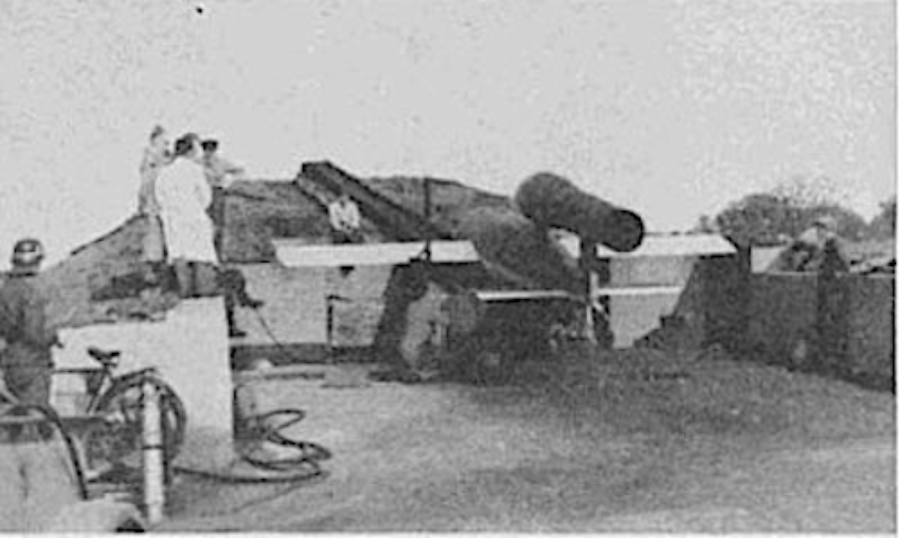
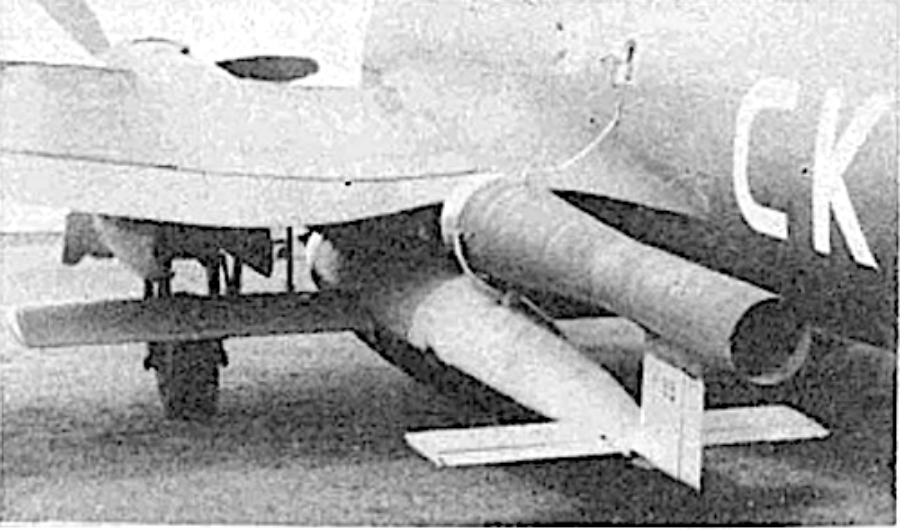
V-1s were launched from either fixed sites, semi-mobile sites or “He III K” bombers. Top left: picture shows a Peenemünde ramp. Top right: picture a V-1 under a Heinkel’s left wing. U.S technicians built ground sites that were far more efficient and mobile than any designed by the Germans
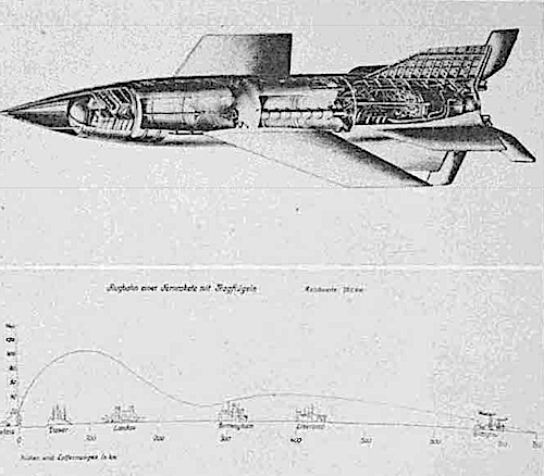
Modified from the V-2 (A-4) was the winged version called the A-4b, (see also frontispiece). As the German official trajectory chart shows, the wings may have reduced speed, but prolonged the range by glicle. Top: is cross-section. Chart figures; are in kilometers (1 km=0.62 mi.). Calais is shown as the launching site.
The whole propelling system is so simple that it allows rapid production. The V-1 has a range o! about 150 miles. and carries a warhead of 2.000 pounds of high explosive. The over-all weight at launching is 4,860 pounds, 836 pounds of which is fuel. It is approximately 25 1/2 feet long, with a wing spread of 171/2 feet. The V-l·s principal defect was its low speed for a guided missile. This made it susceptible to countermeasures, particularly by antiaircraft artillery firing VT fuzed projectes. While the V-1 and V-2 were operational.
German scientists have emphasized the point that these developments must not be regarded as examples of any but the first tentative steps in the ground-to-ground guided missiles business. Illustrative of this fact are the plans which the Germans had drawn up for development of the V-2. For instance, just by adding wings on the V-2, this typeof missile could obtain a great increase in range. As the missile fell to earth, it would assume a flatter glide angle than its normal fall and stretch out its flight to approximately 350 miles.
This type of rocket the Germans called the A-4B; they actually built some for test. With it, they counted on being able to hit any port in the British Isles.
Only on the drawing boards. were more fantastic weapons yet. The most interesting was A-9/A-10 combination. Outgrowths of the V-2, they were the rocket group capable of being fired across the Atlantic. The A-10 was the main and initial rocket, carrying 125,000 pounds of fuel. Once it had taken off , V-2 like, and made most of a round trip into the outer layers of air, it would fall apart. The nose would then turn out to be a V-2 sized winged rocket which would kake off on a flattened, ignite its propellant and travel under its own power to its target on a course roughly parallel to the curvature of the earth.
The A-9 would have lacked the velocity of an ordinary V-2 because of its flat trajectory. Unless the Germans had worked out a good guiding system, its accuracy would have been very poor. It would have represented a great deal of effort just to get a V-2 warhead to the U. S. side of the Atlantic, but the fact remains that, in 1939-1945, the Germans not only thought of doing it, but were planning to do so. And 1946 was the date they had scheduled for operations.
AIR-TO-SURFACE MISSILES
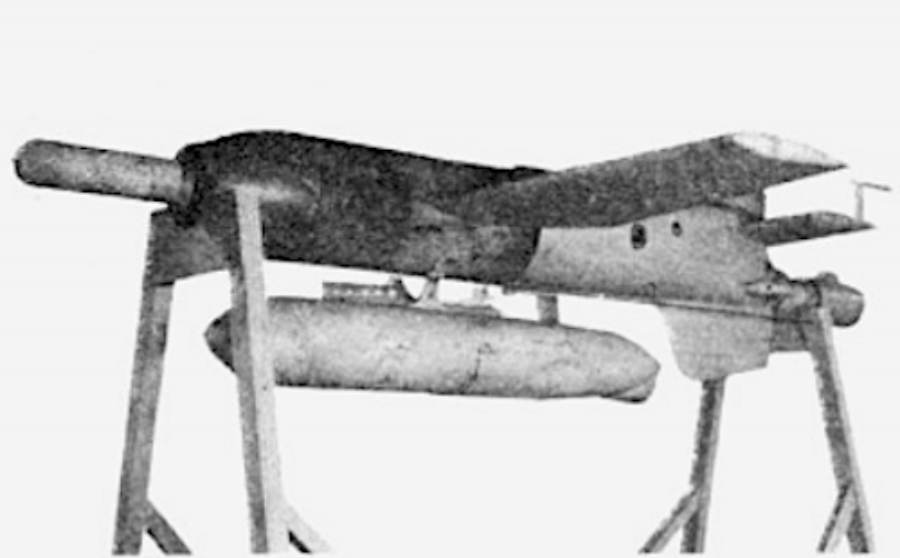

Above:
The “Buck Rogers” device represents a most important weapon for use against shipping and was used against allied craft in the mediterranean.
Above:
It is the radio-controlled He 239” bomb: shown above is a later modification. These could be fitted with wire control.
AIR-TO-SURFACE MISSILES
Of obvious immediate practicality are the air-to-surface missiles. Most soldiers and certainly fliers are aware of the hail of flak that a well-guarded convoy or fleet at sea is capable of releasing. They also know what· defending fighters can do in close cooperation with that flak defense. However, if the attacking aircraft can stay well away from the .defenses, and yet guide .their bomb to its target in spite of the dodging of ships after the bomb is released, both active defense and evasive action will be largely cancelled. To take advantage of such a possibility the Germans put into service the first controlled bombs-the FX-1400 and the Hs 293. That this type of guided missile should be the first one in service is logical, for a wire-controlled bomb was the German Army’s first guided missile idea back in 1918.
The German· high-explosive bomb, H s 293, is a radio-controlled, rocket propelled glider, designed primarily for use against merchant ships and naval craft. It is usually released from the parent plane at an altitude of 3,000 to 5,000 feet, and at a distance from the target of from 3 to 5 miles. It is not released directly at the target, but on a parallel course, and is directed by radio from the parent plane. Upon release, the rocket propulsion unit automatically goes into action, developing a thrust of about 1,500 pounds for a period of 10 to 15 seconds. This accelerates the missile to a maximum speed of 375 miles per hour, but later drops to about 250 miles per hour. Including the warhead of 1,300 pounds of high explosive, the Hs 293 weighs one ton. It is approximately 12 feet long, and has a wing span of 10 feet. The tail is provided with flares and an electric lamp with a “tracer” light to aid control from the plane. Experimental models have been equipped with proximity fuzes.
The H s 293 was used quite successfully in the Mediterranean area, and appears to have been first used in an attack on British antisubmarine vessels off Spain in September 1945. Later models which were perfected., although they never quite reached the operational stage, were designed to be both radio and wire controlled in the event that Allied jamming should interfere with normal radio control. Another modification was a missile incorporating a television transmitter which sent a target picture from the missile to the bombardier. Though the H s series were effective, they were high-explosive bombs. Naval craft are armored and, at any rate, better protected against high explosive blast than merchantmen. Hence there was needed a guided missile that would pierce armor – and which would also have the necessary accuracy to score a direct hit on naval vessels. The Germans answered this need with the FX -1400 radio-controlled bomb. This bomb appears to have been first used in July 1943 in Sicilian waters.

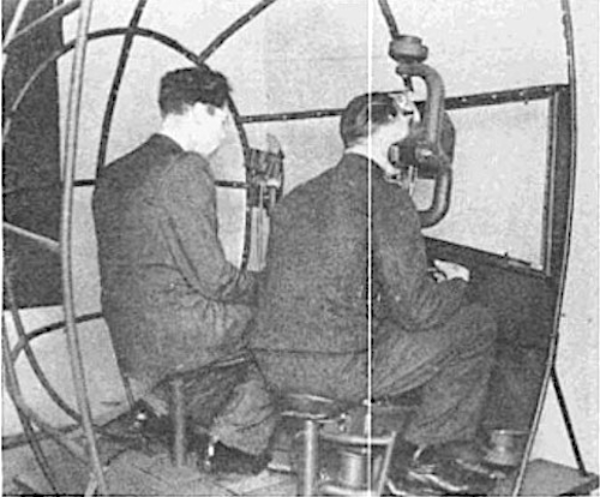
Above:
This German photo show a four-engine Focke-Wulf bomber carrying two of a late model Henschel (Hs) radio-controlled, rocket-powered bomb. The way the Germans worked control after release shows that there was more to guided bombing than just launching the bomb and steering it to the target.
Above:
Trained personnel with special instruments had to track the bomb, while the plane had to execute a definite flight problem in relation to the path of the missile and course of target
Smaller than the He 293, the Fx – 1400 makes it possible to mount two or three missiles on a single bomber. The FX – 1400 is also capable of being carried in the standard bomb rack used on at least six types of German planes. Just under 11 feet long, it weighs 3,080 pounds. It has two pairs of short metal wings, and an oval-shaped tail surface. A gyroscope and radio-control circuit steady the missile and control its course sufficiently lo permit a theoretical direct hit within 20 feet from an altitude of 20.000 feet. The FX-1400 develops a speed of 630 miles per hour. Later, a wire control was developed to counteract jamming.
Later models, which the Germans were unable to get into the operational stage, reached the supersonic speed of 900 miles per hour. and could be dropped from an altitude of 40.000 feet. The new design made use of a spin-stabilization in which the whole missile rotated at the rate of about 60 rounds per minute. A new radio control was developed for control while spinning.
The Italian battleship, Rorna, was sunk with an FX-1400 which apparently hit the upper deck abreast of B turret, causing first a small explosion, and then a magazine explosion. This bomb is believed to have penetrated 8 inches of armor.
The advantages of air-to-surface guided missiles in naval warfare, and in counter-amphibious operations, is obvious from the characteristics of the German missiles. With guided features overcoming evasive action, with the plane able to remain beyond the fleet’s guns, and with the missile arriving at supersonic speeds at which anti aircraft fire is extremely difficult, the problem of naval defense against air attack is tremendously complicated.
SURFACE-TO-AIR MISSILES
Perhaps of greatest interest to both airmen and ground soldiers are the surface-to-air. or flak-type guided missiles. To the Germans. they were a most vital field. Concentrated German flak defense of the conventional gun type might shake up US daylight strategic raid,. but they could not in the end, do more than harass them.
In the flak guided missile, the Germans thought they might have the answer to superior Allied air power. They thought the might end the rule of the air over Germany by the R.A.F the 8th. and the 15th Air Forces. Air-to-air guided missiles were also a good idea, but since the chances of getting fighters up to combat the Allies was reduced toward the latter days of the war, the main reliance had to be put on flak. The Germans therefore pushed several projects for flak guided missiles, instead of picking out just one type for final development and production.
One type was the Natter (Viper) -a small, piloted, rocket-propelled interceptor which was designed to provide a defense for vital areas against bomber formations. It is actually a 2-ton plane. 19 feet long. and with a wing span of 10.5 feet.
The Natter is designed to be launched vertically from a ramp with the assistance of four solid-propellant rockets which. once consumed, a.re jettisoned. An automatic pilot controls it until the human pilot is ready to lake over. Then the main rocket motor is used to close in on the target.
The pilot aims his rocket at the target. fires a salvo of some two dozen rockets from the nose. and trips a device which ejects him and the main rocket motor for descent by parachute.
This piloted missile has a horizontal speed of 620 mile per hour. a climbing speed of 435 miles per hour. and a ceiling of 39.000 feet. It is a purely defensive weapon. conceived in August 1944. built and tested in wind tunnels in November and given a premature test in February 1945. The pilot was accidentally killed. Other tests were completed but no missiles reached actuaJ operations.
Potentially. this weapon is versatile and well-nigh invulnerable. but its main disadvantage is a short horizontal radius of action.
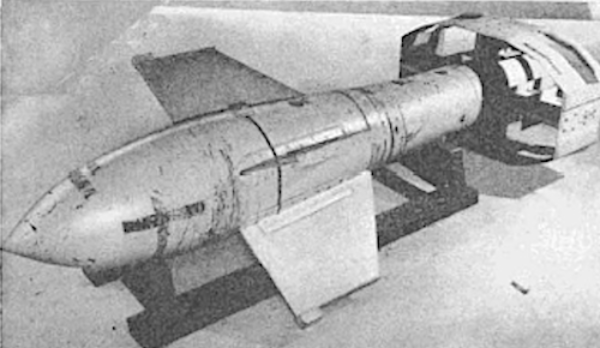
Above:
The “Frit;. X,” or “FX-1400,” is believed to have been the first operational guided missile. An armor-piercing, radio-controlled bomb for use against warships, 0ne of this type sank the big new Italian battleship “Roma” as she was steaming down to Malta at the time of the surrender.
Of the flak rockets designed as guided missile, the Germans were pushing four main types, known under code names as the Wasserfall, Rheintochter, Enzian, and Hs 117. Various types of control were planned, including visual-with-radio, and homing device$ 11 ithin tlw missiles themselves.
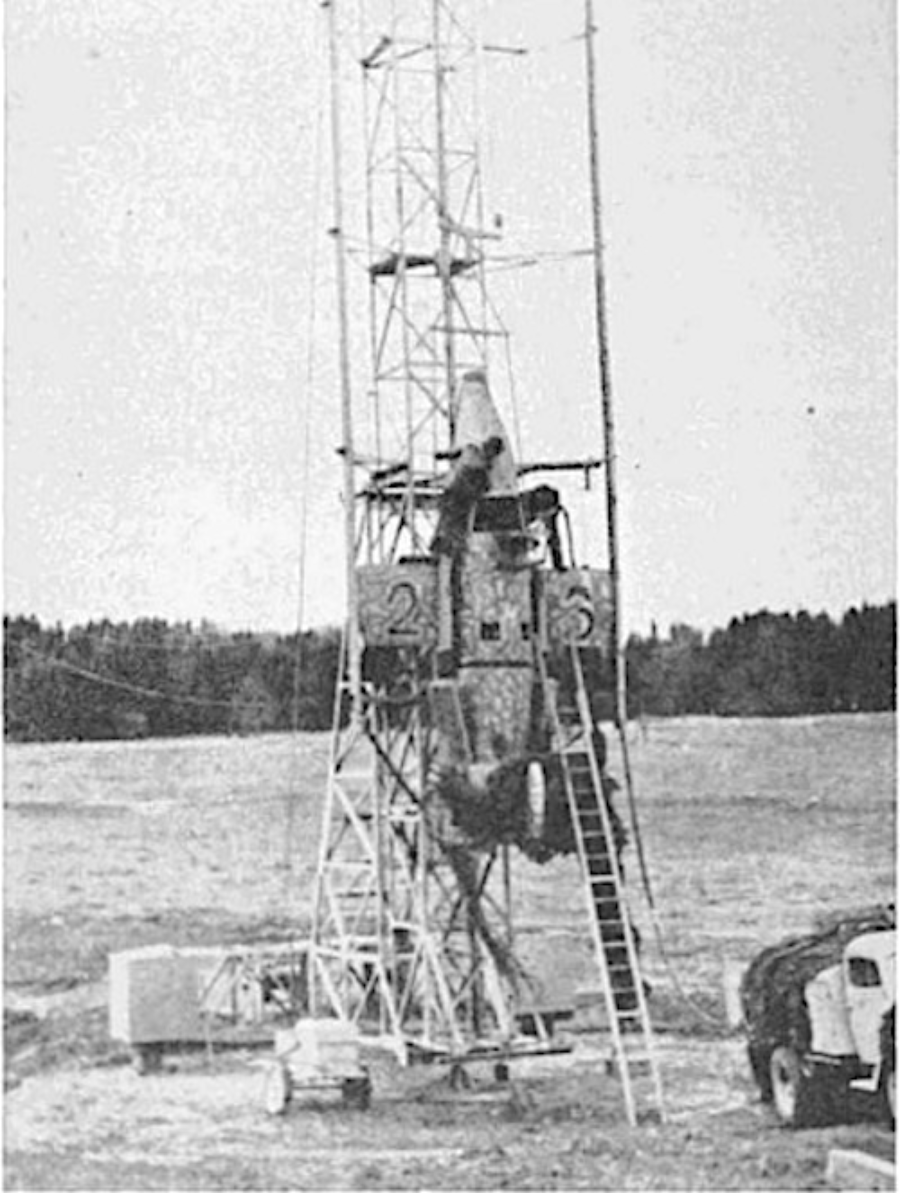
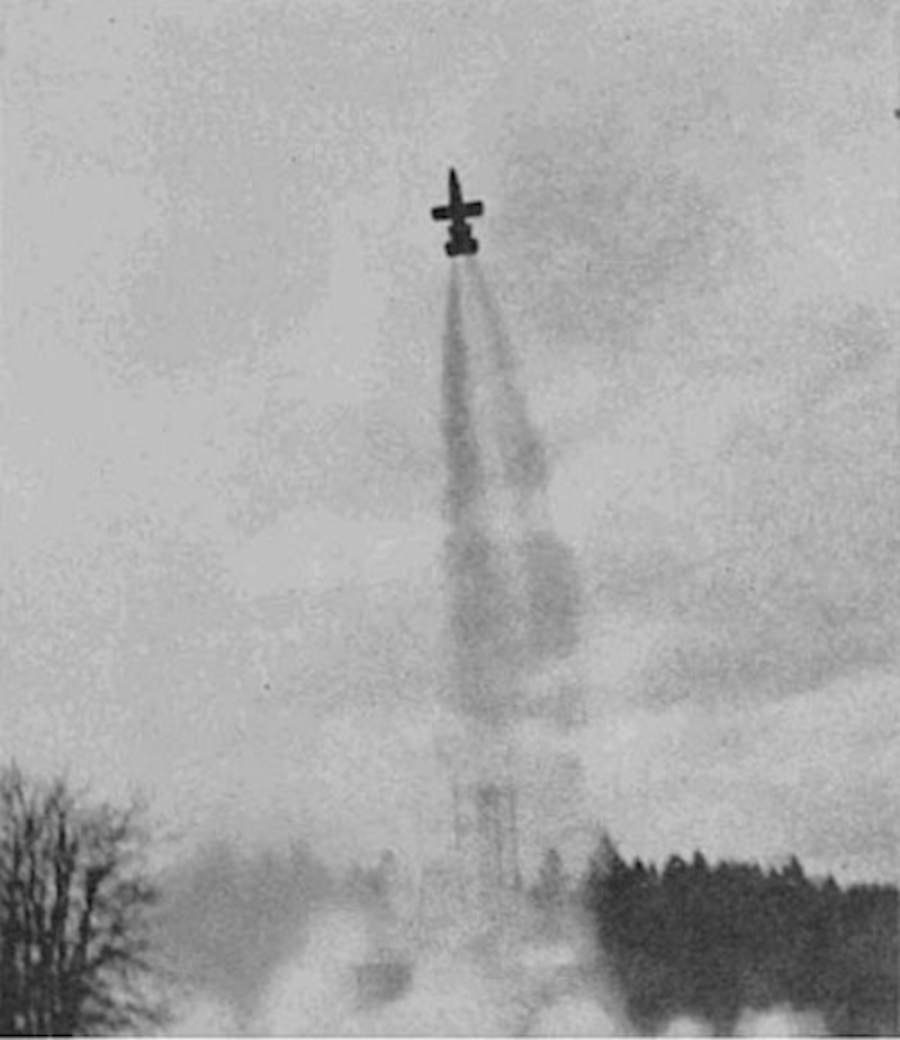
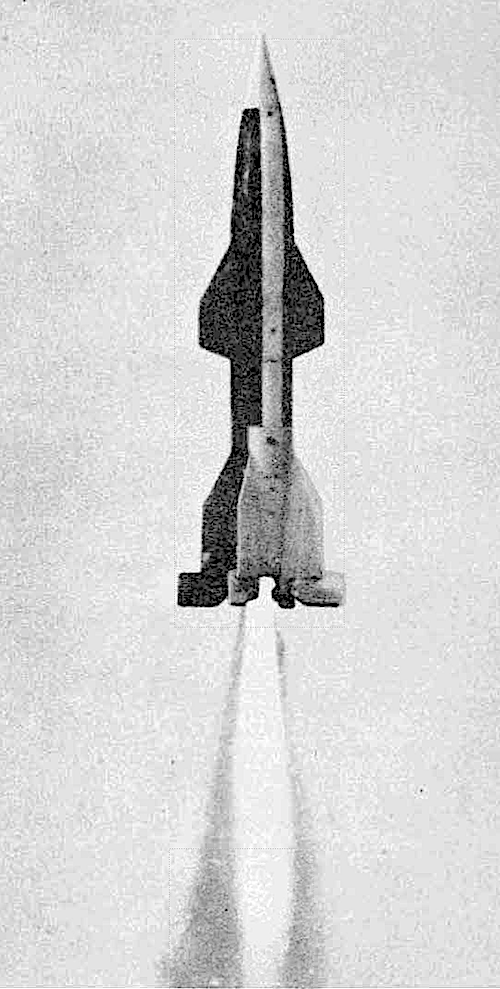
Above:
The “Natter” was launched from a frame in the manner of a projectile from a gun. The pilot assumed control after the missile was airborne. The “Natter” represented a cross between a fighter and a suicide-typem aircraft.
Above:
Launching of the “Natter” was impressive. The blast of its rocket gives an idea of the power used in attaining a climbing speed of 435 miles per hour – about 38,000 feet in a minute. This speed was attained climbing almost straight up.
Above:
The real flak weapon, which might have cleared the skies over Germany was the
Of the flak rockets designed as guided missile, the Germans were pushing four main types, known under code names as the Wasserfall, Rheintochter, Enzian, and Hs 117. Various types of control were planned, including visual-with-radio, and homing device$ 11 ithin tlw missiles themselves.
The Wasserfall was a promising rocket resembling a junior V-2. A supersonic missile, it was designed to destroy an aircraft flying 560 miles an hour at 65,000 feet. at a horizontal range of 30 miles. It measured all of 25 fleet long and weighs 4 tons, on the ground. Launched vertically, like the V-2, it generate about a 9 ton thrust for about 54 seconds. In that time it picks up a speed of 2,500 feet per second (1.700 miles an hour, and almost the 2,805 feet-per-second speed of an M1 rifle bullet. This speed is achieved upon attaining an altitude of 60,000 feet.
initially the German guiding scheme was to provide two radar sets for tracking with radio for control. Later, an infrared proximity fuze and homing device were scheduled for installation. Though the design was finished in 1943. and 25 missiles had been fired and final operational tests completed in January of 1945, the Wasserfall development was nol concluded before the war’s end. The Germans had nevertheless begun work on its production. hoping that it would be the high altitude flak weapon they needed so badly.


Above:
Cosily nestling under the belly of a Dornier medium bomber, the “FX-1400” is here shown ready for use. Had such guided missiles been ready in 1941, their effect on the British Navy might have had sweeping consequences on the course of the war. As it was, the “FX-1400” wasn’t used until 1943
Above:
At first complacent in the face of the strategic bombing threat, the Germans in 1943 became fearful, then frantic. They were willing to try out any possibly effective counter-weapon. One of these trial weapons was the piloted rocket called the “Natter”, a test model of which is shown here
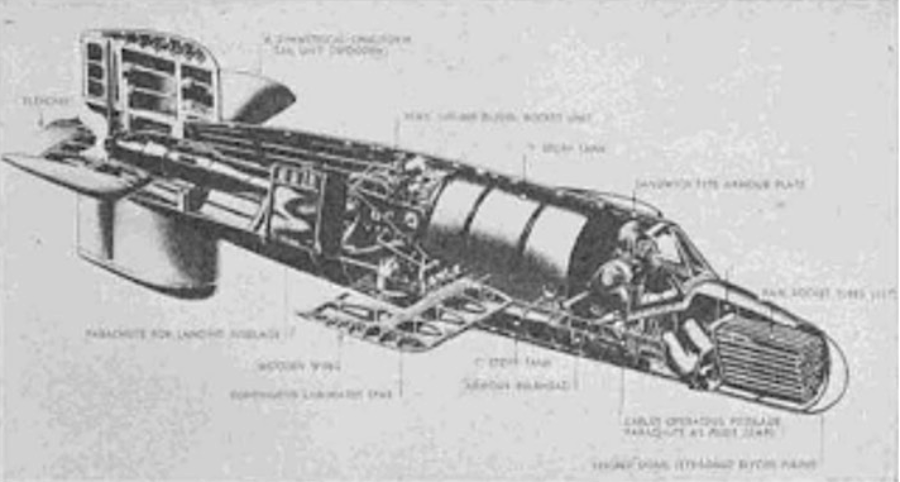

Above:
A cross-section of the “Natter” illustrates its components parts. The rocket fuel is a liquid, as in the V-2 type of rocket. The chute was used to prevent wrecking the main motor, which, like the pilot, was jettisoned.
Above:
The fat “”Enzian” was another of the flak-rocket guided missile projects selected by the Germans for development. Its relative size may be judged from the 88-mm gun mount on which it is shown The launching of the “Enzian” is seen below. Fortunately, none of these projects had passed from test into operations before the armistice.
Of the princinciple flak missiles, the Rheintochter went through several version. It was a development of Hermann Goring’s great Rheinmetall-Borsig arms firm. The Rheintochter 1, fired from an 8.8-cm flak 41 carriage is shown on the cover.
The Enzian, named after a pretty blue flower, was a short fat rocket fired from an altered 8.8-cm flak 18 type carriage, while the Hs 117 was a thinner small rocket, similarly launched
AIR-TO-AIR
While flak rockets were possibly decisive value to the Germans, their dwindling Luftwaffe could nevertheless have made great use of the various air-to-air guided missiles that were feverishly developed. The advantage of such missiles lay in the attackers ability to stay outside a B-l 7’s .50-caliber gun range. and to deliver an accurate missile that would pack enough explosive to deal with even such a well-built ship.
Just how German aircraft would have gotten by the bomber’s fighter cover is another matter. but the possibilities for a situation in which neither side has absolute command of the air. are quite apparent.
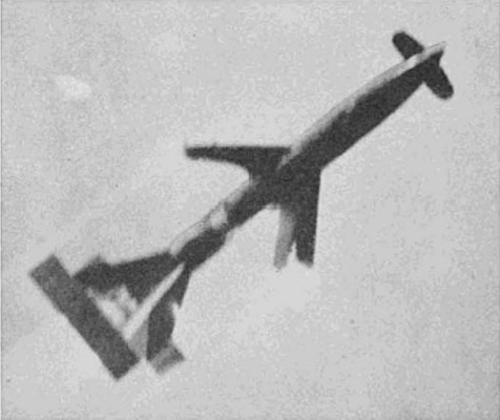
Above:
So urgent was the need for flak rockets when previously overconfident Nazi leaders recognized the air menace that some four types were pushed to completion. One of the types was the “Rheintochter” series. This photo show one of thee weird “Rheintochters” in flight.
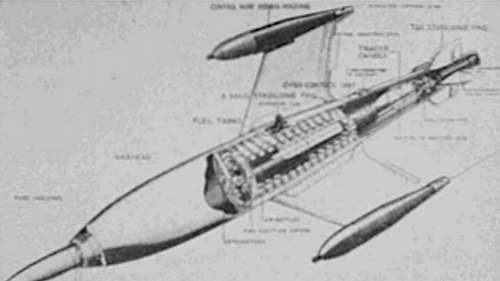
Above:
Though Germany was hopelessly outclassed in the air, guided missiles launched against Flying Fortresses and Liberator from German fights might have had considerable effect in combat strategic bombing. This cross-section view shows the German “X-4”, a rocket- guided missile scheduled for operational use.
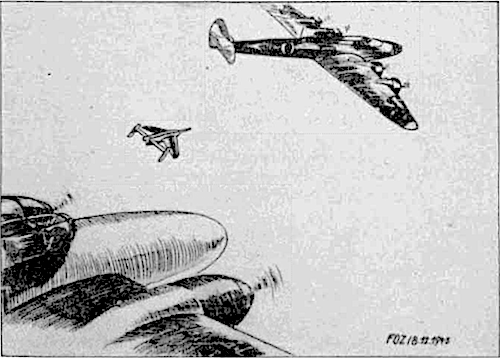
Above:
This German sketch illustrate a German twin-engined fighter guiding an “He298” rocket powered missile against a US B-17. In this case, the fighter crew flies the guided missile with a control stick which creates signals transmitted by radio to the control of the missile itself.
One of the typical German air-to-air missiles was the X-4. The X-4 is a small, 6½-foot, four-winged missile designed to shoot down one aircraft after being launched from another. It is controlled by electrical impulses transmitted over two wires which unreel back to the parent plane. It weighs 132 pounds, and has a warhead of 44 pounds. Designed to be launched from fast fighter aircraft, the rocket has a range of 2,700 yards. The rocket fuel produces an initial thrust of some 300 pounds, which falls off to about 50 pounds after 30 seconds.
Stability is achieved by means of four plywood wings designed to rotate the missile at 60 revolutions per minute. The four fins at the tail have rudders which give it horizontal and vertical control on command of the pilot. Two wire spools mounted on the missile’s wings play out fine wire from the X-4 to the parent plane. A commutator device in the missile transmits the commands into correct time impulses to the rudders. ‘J;’he fuze consists of a combination impact, self-destroying, and acoustic proximity type. The X-4 was in production at the end of the war, but outside of some successful firing tests it did not reach actual combat operations.
CONCLUSIONS
Observation and evaluation of the work of the German scientists at Peenemiinde has not been completed. It is possible, however, to draw a conclusion as to the goal toward which they were working. Obviously, their ultimate objective was the day when they would be able to hit with accuracy any area on the face of the earth with weapons which could carry great destructive power in the form of high explosives.
No guided missile developed by the Genpans is a logical weapon to be exactly duplicated for practical use by any other nation. However, further development of the guided missile to provide weapons for possible future conflict is logical and perhaps necessary. German experimentation has provided a basis for intensive study of the subject. Guided missiles have provided new problems for all the services. The Germans very nearly had an effective countermeasure against bombing.
Within a short time they would have produced infinitely superior assault weapons. German advances in the field of guided missiles gives emphasis to the thought that the country which neglects, until the time of war, the development of new weapons with which it may be compelled to fight in the future, will not survive the first assault, if attacked by an astute aggressor.

